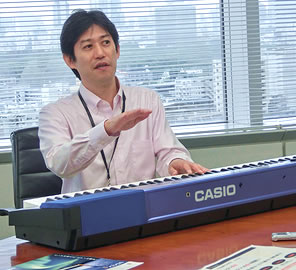

Product Planner
Akira Sakashita
Key project team member from the time of start-up
Infusing CASIO's Vaunted Advanced Miniaturization Technologies
I work in a marketing section that plans global sales strategies and have participated in the Privia project right from the initial planning stage. Although at that time CASIO was already manufacturing and selling digital pianos, the Privia project was launched as an attempt to create an unprecedented compact digital piano with a slimmer profile that people could enjoy playing in private. Market research showed that this was a latent need that would increasingly manifest itself, and furthermore, product miniaturization is a technology at which CASIO excelled, having achieved solid results with a variety of products including calculators, wristwatches, and electronic dictionaries. Although it took about two and a half years to progress from concept to product launch, the tremendous reaction from the market and industry when the first model was introduced is an unforgettable memory.


The Name is a Shortened Form of "Private Piano"
From my perspective as a product planner, a major reason the Privia has meet with widespread acceptance is that we prepared a highly distinctive product line. Even at the initial introduction stage ten years ago, we simultaneously launched the PX-100, the standard model in the line, the PX-300, which has a full complement of features for stage performances, and the PX-500L, with light-up keys for easy learning. In the first place, the name Privia was coined by shortening the phrase "private piano." Our aim was to evolve the piano from a heavy, bulky instrument found in the living room to one that people can enjoy in the privacy of their own rooms. The Privia reflects the desire to make the piano a more accessible musical instrument, in much the same way that televisions and other home appliances have gradually penetrated into every room of the house. I believe that the Privia product line of distinctive pianos to suit the preferences of every piano lover fully measures up to the aspiration expressed in the product name.
Evolution: Past and Future
During the past ten years, the Privia has evolved in many ways. We have tirelessly pursued innovative style together with basic performance as a musical instrument by means such as reproducing acoustic piano tonal changes over time and adopting the three sensor system for delivering a more authentic playing experience. Although this product planning and development approach won't change, I think that further evolution characteristic of the Privia is necessary. I'm keen to create unprecedented functions and new playing situations and occasions because CASIO has the necessary imagination and technological capabilities to make it happen. For instance, although it's only a dream at this point, wouldn't it be great if there were pianos compact enough to take with you anywhere? My greatest desire is to bring that kind of new joy and astonishment to users.


Objectives for the Tenth Anniversary Models
Development of the tenth anniversary models began with the idea of creating something totally unique. We returned to the Privia concept and aimed for new value proposals unavailable from existing products. The result was two models: the PX-A100 series of pianos in red and blue metallic colours and the PX-A800, which features a completely new natural woodgrain pattern. Although the original idea was to make the PX-A100 available in seven colours, we narrowed down the selection to red, symbolizing movement, and blue, symbolizing rest. The natural wood grain of the PX-A800 has resulted in a distinctive design clearly differentiated from the wood grain used for other digital piano models you see in stores. In terms of function, the most distinctive new feature is probably the Hall Simulator, which simulates the acoustics of ten different concert venues, including world-famous concert halls, a church, and an outdoor stadium. Since the Privia incorporates CASIO's vaunted high-performance LSI sound source, we wanted to take advantage of this strength and build in a function that would fulfill users' musical aspirations. I think that as a result we were able to realize models that deliver unique value befitting the tenth anniversary of Privia digital pianos.




